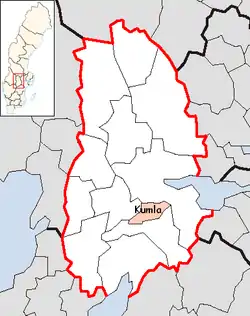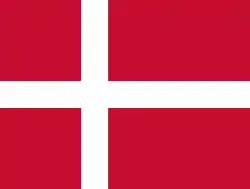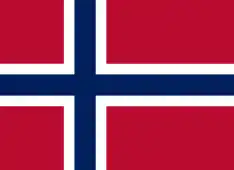Kumla Municipality
Kumla Municipality (Kumla kommun) is a municipality in Örebro County in central Sweden. Its seat is located in the city of Kumla.
Kumla Municipality
Kumla kommun | |
|---|---|
 Coat of arms | |
 | |
| Country | Sweden |
| County | Örebro County |
| Seat | Kumla |
| Area | |
| • Total | 205.8 km2 (79.5 sq mi) |
| • Land | 204.18 km2 (78.83 sq mi) |
| • Water | 1.62 km2 (0.63 sq mi) |
| Area as of 1 January 2014. | |
| Population (31 December 2019)[2] | |
| • Total | 21,738 |
| • Density | 110/km2 (270/sq mi) |
| Time zone | UTC+1 (CET) |
| • Summer (DST) | UTC+2 (CEST) |
| ISO 3166 code | SE |
| Province | Närke |
| Municipal code | 1881 |
| Website | www.kumla.se |
The present municipality was formed during the latest nationwide local government reform in Sweden, with the amalgamations taking place in 1966 and 1971.
With 207 km² it is the smallest municipality in Örebro County.
Localities
- Ekeby
- Hällabrottet
- Kumla (seat)
- Kvarntorp
- Sannahed
- Åbytorp
Elections
These are the results of the elections in the municipality since the first election after the municipal reform, being held in 1973. The exact results of Sweden Democrats were not listed at a municipal level by SCB from 1988 to 1998 due to the party's small size at the time. "Turnout" denotes the percentage of eligible people casting any ballots, whereas "Votes" denotes the amount of valid votes only.
Riksdag
| Year | Turnout | Votes | V | S | MP | C | L | KD | M | SD | ND |
|---|---|---|---|---|---|---|---|---|---|---|---|
| 1973[3] | 91.1 | 10,783 | 5.5 | 48.2 | 0.0 | 24.6 | 9.7 | 3.5 | 8.0 | 0.0 | 0.0 |
| 1976[4] | 92.2 | 11,533 | 4.6 | 47.3 | 0.0 | 25.9 | 10.6 | 2.6 | 8.9 | 0.0 | 0.0 |
| 1979[5] | 91.1 | 11,745 | 4.9 | 49.0 | 0.0 | 18.9 | 10.3 | 3.0 | 13.5 | 0.0 | 0.0 |
| 1982[6] | 91.9 | 12,039 | 5.2 | 52.1 | 1.3 | 16.1 | 5.7 | 4.1 | 15.4 | 0.0 | 0.0 |
| 1985[7] | 91.0 | 12,030 | 4.8 | 51.8 | 1.2 | 16.2 | 12.7 | 0.0 | 12.9 | 0.0 | 0.0 |
| 1988[8] | 87.3 | 11,624 | 6.0 | 50.0 | 3.6 | 12.7 | 11.3 | 5.2 | 10.8 | 0.0 | 0.0 |
| 1991[9] | 88.8 | 12,111 | 5.0 | 43.0 | 2.0 | 9.6 | 8.3 | 9.8 | 15.0 | 0.0 | 7.0 |
| 1994[10] | 87.8 | 12,127 | 7.3 | 50.9 | 4.0 | 8.0 | 6.8 | 6.5 | 14.5 | 0.0 | 1.4 |
| 1998[11] | 82.8 | 11,489 | 13.0 | 43.6 | 3.3 | 5.9 | 4.2 | 12.1 | 15.9 | 0.0 | 0.0 |
| 2002[12] | 82.4 | 11,573 | 7.8 | 48.5 | 3.1 | 7.2 | 9.3 | 10.4 | 10.1 | 2.2 | 0.0 |
| 2006[13] | 84.6 | 12,011 | 4.7 | 47.3 | 2.9 | 7.4 | 6.1 | 8.9 | 16.5 | 4.4 | 0.0 |
| 2010[14] | 86.6 | 13,022 | 4.2 | 41.1 | 4.7 | 5.2 | 6.3 | 6.9 | 23.4 | 7.2 | 0.0 |
| 2014[15] | 87.7 | 13,529 | 4.3 | 38.2 | 5.0 | 5.1 | 5.0 | 5.8 | 18.0 | 16.3 | 0.0 |
Blocs
This lists the relative strength of the socialist and centre-right blocs since 1973, but parties not elected to the Riksdag are inserted as "other", including the Sweden Democrats results from 1988 to 2006, but also the Christian Democrats pre-1991 and the Greens in 1982, 1985 and 1991. The sources are identical to the table above. The coalition or government mandate marked in bold formed the government after the election. New Democracy got elected in 1991 but are still listed as "other" due to the short lifespan of the party.
| Year | Turnout | Votes | Left | Right | SD | Other | Elected |
|---|---|---|---|---|---|---|---|
| 1973 | 91.1 | 10,783 | 53.7 | 45.8 | 0.0 | 0.5 | 99.5 |
| 1976 | 92.2 | 11,533 | 51.9 | 45.4 | 0.0 | 2.7 | 97.3 |
| 1979 | 91.1 | 11,745 | 53.9 | 42.7 | 0.0 | 3.4 | 96.6 |
| 1982 | 91.9 | 12,039 | 57.3 | 37.2 | 0.0 | 5.5 | 94.5 |
| 1985 | 91.0 | 12,030 | 56.6 | 41.8 | 0.0 | 1.6 | 98.4 |
| 1988 | 87.3 | 11,624 | 59.6 | 34.8 | 0.0 | 5.6 | 94.4 |
| 1991 | 88.8 | 12,111 | 48.0 | 42.7 | 0.0 | 9.3 | 97.7 |
| 1994 | 87.8 | 12,127 | 61.2 | 35.8 | 0.0 | 3.0 | 97.0 |
| 1998 | 82.8 | 11,489 | 59.9 | 38.1 | 0.0 | 2.0 | 98.0 |
| 2002 | 82.4 | 11,573 | 59.4 | 37.0 | 0.0 | 3.6 | 96.4 |
| 2006 | 84.6 | 12,011 | 54.9 | 38.9 | 0.0 | 6.2 | 93.8 |
| 2010 | 86.6 | 13,022 | 50.0 | 41.8 | 7.2 | 1.0 | 99.0 |
| 2014 | 87.7 | 13,529 | 47.5 | 33.9 | 16.3 | 2.3 | 97.7 |
Twin towns
Kumla's three twin towns with the year of its establishing:
- (1968) Frederikssund Municipality, Denmark

- (1981) Sipoo (Sibbo), Finland

- (1988) Aurskog-Høland, Norway

References
- "Statistiska centralbyrån, Kommunarealer den 1 januari 2014" (in Swedish). Statistics Sweden. 2014-01-01. Archived from the original (Microsoft Excel) on 2016-09-27. Retrieved 2014-04-18.
- "Folkmängd i riket, län och kommuner 31 december 2019" (in Swedish). Statistics Sweden. February 20, 2020. Retrieved February 20, 2020.
- "Riksdagsvalet 1973 (page 167)" (PDF) (in Swedish). SCB. Retrieved 27 August 2017.
- "Riksdagsvalet 1976 (page 161)" (PDF) (in Swedish). SCB. Retrieved 27 August 2017.
- "Riksdagsvalet 1979 (page 186)" (PDF) (in Swedish). SCB. Retrieved 27 August 2017.
- "Riksdagsvalet 1982 (page 187)" (PDF) (in Swedish). SCB. Retrieved 27 August 2017.
- "Riksdagsvalet 1985 (page 188)" (PDF) (in Swedish). SCB. Retrieved 27 August 2017.
- "Riksdagsvalet 1988 (page 168)" (PDF) (in Swedish). SCB. Retrieved 27 August 2017.
- "Riksdagsvalet 1991 (page 29)" (PDF) (in Swedish). SCB. Retrieved 27 August 2017.
- "Riksdagsvalet 1994 (page 44)" (PDF) (in Swedish). SCB. Retrieved 27 August 2017.
- "Riksdagsvalet 1998 (page 40)" (PDF) (in Swedish). SCB. Retrieved 27 August 2017.
- "Valresultat Riksdag Kumla kommun 2002" (in Swedish). Valmyndigheten. Retrieved 27 August 2017.
- "Valresultat Riksdag Kumla kommun 2006" (in Swedish). Valmyndigheten. Retrieved 27 August 2017.
- "Valresultat Riksdag Kumla kommun 2010" (in Swedish). Valmyndigheten. Retrieved 27 August 2017.
- "Valresultat Riksdag Kumla kommun 2014" (in Swedish). Valmyndigheten. Retrieved 27 August 2017.
External links
- Kumla Municipality - Official site